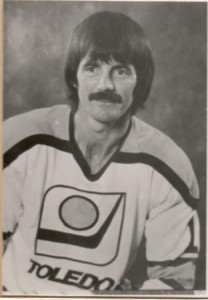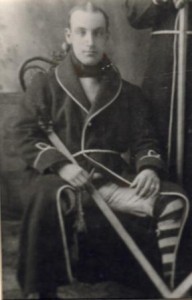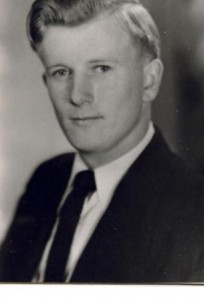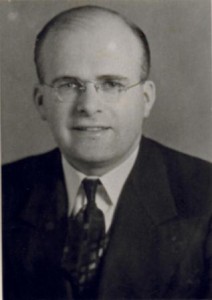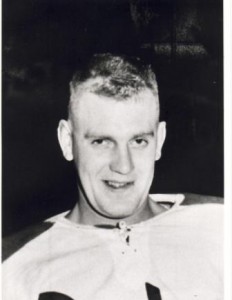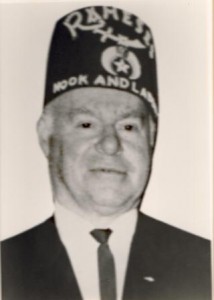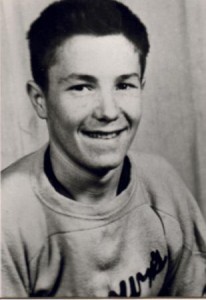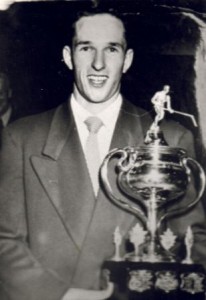 In 1958, he won the Dr. John C. Findley Trophy. The Dr. Findley Trophy is an award presented annually to the athlete adjudged to be the keenest and best competitor in the Town of Meaford. That year, the special citation read “To the little man with the big heart.” That single line is the life story of Collingwood born – Barney Walmsley.
In 1958, he won the Dr. John C. Findley Trophy. The Dr. Findley Trophy is an award presented annually to the athlete adjudged to be the keenest and best competitor in the Town of Meaford. That year, the special citation read “To the little man with the big heart.” That single line is the life story of Collingwood born – Barney Walmsley.
Pound for pound . . . and he never weighed more than 135 of them. . . Barney was one of the best and gamiest athletes ever to come out of Collingwood’s East End, and there were many games ones spawned in the shadow of the old Connaught School.
He excelled at every game he played; hockey, baseball, softball, football, track and field and even table tennis. Barney played them all and won them all – well and clean.
There are not many stick handlers left in the game of hockey. The stick handler has been discouraged in this era of hit, charge and shoot but Barney can be classed as one of the last of the good ones.
He had everything but weight on the ice with the big fellows. He weaved in and out of the tight corners like an eel, could attain full flight in three strides, could thread a needle from the port or starboard side with a flicking but powerful wrist shot, could lay a pass on a teammate’s stick from blue line to blue line, rarely lost a face-off and never, stopped trying and hustling.
Born on January 15, 1931, Barney skated a few days after he learned to walk.
His hockey career started with the formation of the Collingwood Minor Hockey Association back in 1945 when that organization boasted only four junior teams. He played centre for theEast End and made the first All-Star team the first-time out. He was fourteen and he tipped the scales at exactly 90 pounds, shoulder pads and all.
He jumped up to Midget O.M.H.A. in 1946 and was bitterly disappointed when Hap Emms’ Barrie Club beat them out in the group finals and went on to win the provincial title. Lindsay put the Collingwood team out in 1947 in a tough overtime game and the following year the whole team stepped up into Juvenile ranks. The club went to the finals.
The following year, the Juvenile Cubs won the Ontario title without losing a game. Barney scored 35 goals and set up plays for 81 more.
The following year, Barney and Len Cook went to the St. Louis training camp and St. Louis sent them to the Barrie Colts, a Junior “A” club, coached by Hap Emms.
Emms was very much impressed with Walmsley but he said “Barney you are good enough for any Junior “A” Club right now but you are too small for professional hockey.” The kid was naturally disappointed but he passed up the Junior “A” chance and came back to Collingwood.
That was the beginning of the long reign of the Collingwood Greenshirts. They won the Ontario Junior “C” title four years in a row.
In 1950, Barney scored 50 goals and at the end of the season, Baldy Cotton, chief scout for the Boston Bruins, asked him to sign with Waterloo in the Junior “A” loop. He was offered a contract but he couldn’t sign because he property of the St. Louis Flyers.
After a great deal of thought, he reasoned that there was no 103 pounders in the NHL and he came back to Collingwood.
He helped the Greenshirts to another title and moved up to the Intermediate ranks under Eddie Bush in 1952 when the Shipbuilders on the provincial championship for the second year in a row.
It was quite a season for Barney. He lost all of his front teeth in the group final against Newmarketbut he never missed a game.
In the Ontario final against the Simcoe Gunners, it was Barney who put the icing on the cake in the fifth game. He scored the cup-winning goal on a pass from Eddie Bush before the end of the 10 minute overtime period. The Gunners turned the tables on the Shipbuilders in the 1953 final.
After another year in Collingwood, he received offers from Orillia, St. Thomas and Meaford. He took Meaford because it was closest to home. Meaford reached the Intermediate “A” finals in the next two years and won the OHA Senior “B” title in 1958.
Barney had played in the OHA Junior, Intermediate and Senior finals for eight consecutive years. Meaford went to the Senior “B” final again in 1963 and two years later Walmsley was back to Collingwood.
The Shipbuilders went to the Senior “A” final in 1965 and Barney moved back to Meaford to finish out his active playing days. He played hockey with the Oldtimers until 1982.
Barney was a slick fielding baseball player and was a member of the Collingwood team which won the Ontario Midget title in 1946. He later played O.B.A. baseball with Collingwood and in the Intermediate ranks with Thornbury, Orillia, Stayner, Creemore and Meaford. His athletic ability was not confined to hockey and baseball as he starred on high school basketball, soccer and football teams. In a Tudhope Track and Field Meet in 1946, he competed in five events and finished with a first, two – seconds and a third.

